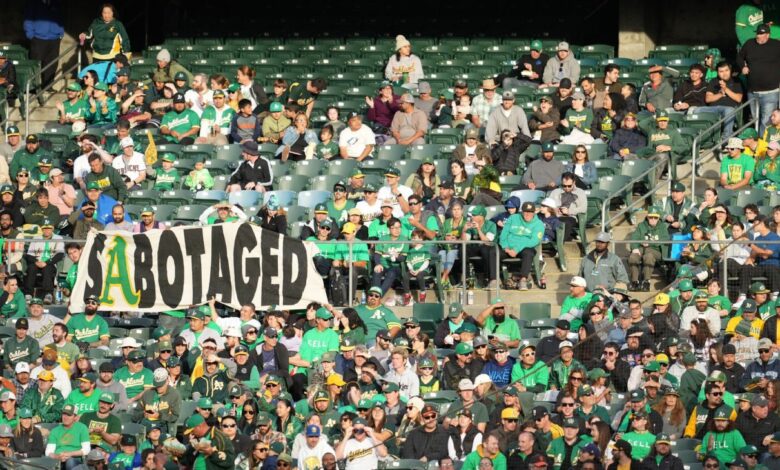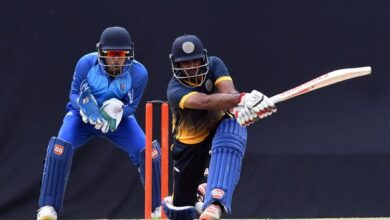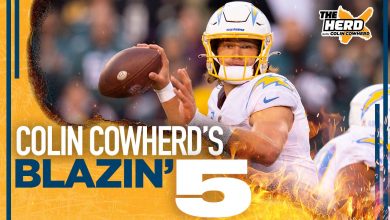Owners’ vote shows the Oakland A’s move is about money, not fans

IT’S IMPOSSIBLE TO romanticize a building as ugly as the Oakland Coliseum. It’s aesthetically cold, a mountain of weathered concrete surrounded by oceans of asphalt. But when it was full, and when the game mattered, nothing compared. The raw noise, the reckless energy, a party always on the verge of getting out of hand. In those moments, it’s always been the kind of place — lawless, reckless, all the volume cranked up inside every single body — that demands you pay attention.
There will be no more big games there, perhaps no more games, period. The owners of Major League Baseball and Commissioner Rob Manfred completed the mission of Oakland Athletics owner John Fisher on Thursday when, sources told Jeff Passan, team owners voted unanimously to allow the A’s to relocate to Las Vegas. They voted without all the required information, and they voted to reward someone whose trustworthiness is in dispute with a market they’ve long viewed as a gold mine for an expansion team.
Manfred has strewn rose petals along the A’s path to Vegas, maybe because he fears Fisher might lose his way without the help. He agreed to waive the relocation fee (at minimum $300 million to be spread across the other 29 teams) because the deal in Las Vegas wouldn’t be financially feasible for Fisher otherwise. Manfred scheduled the vote despite not knowing where the A’s will play for three seasons between 2025 and 2027 and despite not knowing the design of the ballpark and despite not knowing how Fisher plans to finance the $1 billion to $1.5 billion it will take to build it.
And that’s why, in Oakland, it feels personal. In Oakland, which is on the verge of losing all three of its major professional sports teams in a span of five years, it always feels personal. There’s something about the city and its people that guys like Fisher and Manfred will never understand. Fisher — Gap scion, shadow-dweller, principal owner of the A’s since 2015 — loves to tout his Bay Area roots, but he was born into a life of East Coast boarding schools, Princeton and squash courts. Oakland was never his thing.
When I spoke at length to Fisher and team president Dave Kaval in late August, their stated sympathy for the fans of Oakland felt perfunctory, rote, like the names of A’s prospects Fisher read off a paper on the desk in front of him at one point in our conversation. On Tuesday, he spoke with three A’s fans/protesters who made the trip to Arlington for the owners’ meetings. When Jorge Leon told him how difficult it’s been to watch their team be taken away from them, Fisher, the billionaire, told him, “It’s been a lot worse for me than you.”
Fisher didn’t attend games in Oakland after the April decision to leave town, but Las Vegas will provide him with the proper remove. If all goes according to plan, there will be a sufficient number of luxury suites that generate a sufficient amount of revenue for him to go, if he chooses, without fear of encountering the unsavory aspects of the real world.
A’s fans, with a fair amount of bless-your-heart innocence, felt they could change the course of history with sheer outrage. They derided Fisher with billboards outside the stadium and bedsheet signs inside and airplane banners overhead. They stopped drumming in the right-field bleachers, turning a party into a funeral, and then they threw a reverse boycott party that did the exact opposite. They’ve lived with this prospect for what seems like forever, just as they did when the Raiders were boomeranging up and down the coast and the Warriors were casting their covetous eyes toward San Francisco.
But it’s never been about the fans, or loyalty, or 55 years of history. Fisher can reel off the names of Sal Bando and Catfish Hunter and Tyler Soderstrom and Denzel Clarke, but it’s always been about the search for the next mark, the next wheelbarrow of free money, the next lobbying tactic that produces the most corporate welfare. The team is a line on a spreadsheet, nothing more than an asset in a billionaire’s portfolio. The people left behind don’t matter. The cruel truth is, they never did.
THERE WAS NO suspense surrounding this vote. Despite all its holes, the plan to move the A’s to Las Vegas is seen by every other owner as a way to insure their own future grift. And to deny the A’s relocation would have served as a de facto vote of no confidence for Manfred. His cheerleading for this move, and subsequent belittlement of both Oakland and its mayor, Sheng Thao, exposed a brittle side to his personality.
Charitably, it could be called a strategy. For the Athletics to convince the owners they needed to move, they had to sell the case that Oakland was not a worthy home for Major League Baseball. Not just that ballpark, which nobody can reasonably defend, but an entire region. They did this systematically and cynically, by stripping the team like a stolen car and leaving the husk to rot in the sun. They discarded young stars and left the stadium to decay on its own terms while dismissing the efforts of city officials in raising nearly $1 billion for infrastructure to build Fisher’s Oz-like $12 billion waterfront mini-city at Howard Terminal.
They didn’t try to hide it. Kaval admitted — flat-out admitted — to me that the team abandoned any effort to make the Coliseum a better place to watch a game at the beginning of the 2021 season, when he and Fisher decided to embark on a “parallel paths” of pitting Oakland against Las Vegas. In the end, “parallel paths” appears to have been another strategic maneuver to ease the franchise out of Oakland.
It ushered in three years of a gutted team, an intentionally grim stadium and — get this — higher ticket prices, including many season-ticket plans that doubled between 2022’s 102-loss season and this year’s 112-loss season. The team drew an MLB-worst 832,342 fans in 2023 and presto — blame the city and move to Vegas.
The same week I spoke to Kaval I spoke to Fisher, who was ending a string of three interviews, the only three he’s given in 18 years as an owner. “We start off the season like everybody, every other ball team does, tied for first,” Fisher said. “You start out with very high hopes for what your team is going to be able to achieve. And then you play the games.”
I didn’t report those words at the time, mainly because I couldn’t decide whether they were the product of ignorance, duplicity or some combination of the two. Because those pesky games, the ones that didn’t go the A’s way 112 times last season, contained precisely zero surprises, and nobody had high hopes for the A’s last season, not even the guys in the clubhouse.
But what now? What about the immediate now? They’ve got permission to move to a city that, to this point, has managed to keep its excitement for MLB’s worst team entirely hidden. Beyond that, who knows? The A’s have no idea where they’re going to play after the Coliseum lease expires after next season. That means three years … somewhere, and that’s providing all the construction moves along at pace and the Tropicana hotel/casino is razed and the new ballpark is built in time to open in 2028.
The most logical place for them to play after the Coliseum lease expires after the 2024 season is the Coliseum. The A’s haven’t approached the city about extending the lease, and the people who run the city are in no mood to make the first call, but imagine for a moment the scene in the Coliseum late in the ’27 season, with the A’s 30 games back in the AL West, months away from their first Opening Day in Las Vegas, a couple hundred people watching, one concession stand open, the pall after the pall.
IT WOULD BE easier for the people of the East Bay to understand the decision if someone, anyone, involved in making it could come close to making a coherent argument for why it’s happening. The arguments the team made to procure $380 million in public funding would have failed a middle-school debate class.
They infamously sold the Nevada legislature on a 30,000-seat stadium that would require annual attendance of 2.5 million to reach the financial projections to keep the state from touching the state’s general fund. When it was pointed out that 81 sellouts — a prognostication we can all agree makes fairy tales sound like “Reservoir Dogs” — would mean just 2.43 million fans, Kaval announced new plans: the stadium, magically, would be 32,000 seats.
This is a stadium that exists only in the imagination; no official renderings have been released, and no architect has been publicly announced. The team’s director of design told everyone to “wad up” the original stadium renderings — which appeared to show a ballpark far larger than the land it will occupy, with a field that looked suspiciously like the Coliseum’s — after Nevada’s public money was secured. It will need to be either be a fixed dome or have a retractable roof; the former is a relic of a grim era (Montreal’s Olympic Stadium, the Astrodome, the soon-to-be-placed Trop) while the latter might be an engineering impossibility on the nine-acre Vegas parcel. (Nine acres bordering an off-Strip condo complex and a Catholic church, hardly San Francisco Bay waterfront vibes.)
Fisher can say he spent six years trying to make something happen in Oakland, but that conveniently sidesteps the three years focused on one site (Laney Community College) that Fisher was told was a dead end from the beginning. Then there was the shift to Howard Terminal (“Howard Terminal or bust,” Kaval said) that lasted until the beginning of 2021 (a pandemic got in the way, too) before the team announced its “parallel paths” with Oakland and Las Vegas.
The one time Fisher and Kaval were pressed to explain their decision, their reasoning lacked both substance and coherence. The best they could do was say that Oakland couldn’t guarantee a stadium deal before the team’s January deadline to continue receiving revenue-sharing from the big-market teams in the league. In other words, Oakland didn’t give them enough fast enough to make sure they could get more from somebody else.
Fifty-five years of history, history Fisher claims to honor, tossed aside for expediency. Any attempt to make sense of it — all of it, from Manfred’s rank boosterism to Fisher’s abrupt turn on Howard Terminal — comes back to one question: Will the man who spawned a cottage industry of green-and-white “SELL” T-shirts unload the team once it lands in Vegas? Is there some tacit quid pro quo between Fisher and MLB — you get Vegas for your trouble in Oakland, and we’ll find a new owner so you can cash out once Vegas becomes official and the franchise value skyrockets?
When I asked Fisher if he was planning on selling the team once it gets to Vegas, he gave one in a series of non-answers. He talked about buying a team because he wanted to win. He talked about being a fan and the history of the A’s and Vida Blue and Reggie Jackson. Nowhere in his extended response was an answer to the question.
But Vegas invites reinvention. You can be anything you want in Vegas. It practically begs you to conjure something else. They built skyscrapers in the sand and convinced people from all over the world to travel there to hand over their money. Anything’s possible.
Maybe this is baseball’s hope. Fisher will go to Vegas and become someone or something else. He’ll raise his payroll and keep his good players and treat his customers as if they matter. He’ll wander The Strip and mingle with the people and wear a $5 tank top and try to open a beer bottle with his eye socket. The stands will be full, the team will romp to victory and everyone will wonder why Major League Baseball didn’t ditch Oakland sooner.
At this point, there’s no way to refute any of it. Anything and everything is possible. But there’s always been an undeniable truth about Vegas: Eventually you have to go home to who you’ve always been.




